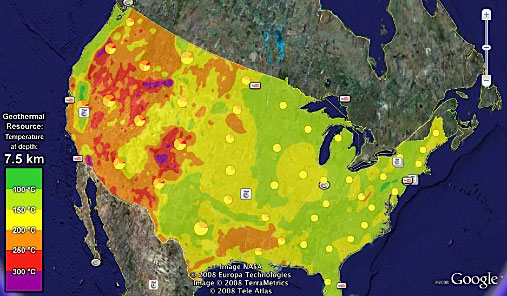Google, Australia give big boost to geothermal power production
Google, Australia give big boost to geothermal energy
mongabay.com
August 20, 2008
|
|
Geothermal energy got a big boost this week with Google and the Australian government announcing multi-million initiatives that make use of Earth’s heat as a clean and renewable source of power.
Tuesday Google.org, the philanthropic arm of search giant Google, said it will invest $10 million in “enhanced geothermal systems” (EGS) to improve the potential of geothermal energy, which harnesses the heat of Earth’s core to generate power. The EGS process works by effectively mimicking a geyser. Water is pumped through holes drilled into the hot rock deep below Earth’s surface. The resulting heated water and steam is then used produce electricity in a conventional turbine. A study published this past January by MIT researchers estimated that just 2 percent of the heat below the continental United States between 3 and 10 kilometers deep is more than 2,500 times the country’s total annual energy use.

|
The recipients of the investment include Potter Drilling, a firm developing new technologies for hard rock drilling ($4 million); AltaRock Energy, a company working on EGS ($6.25 million); and Southern Methodist University Geothermal Lab, which will receive a $489,521 grant to “improve geothermal resource assessment techniques and update the Geothermal Map of North America”, according to Google.
In making the investment, Google touted the potential of EGS to meet global energy needs.
“EGS could be the ‘killer app’ of the energy world. It has the potential to deliver vast quantities of power 24/7 and be captured nearly anywhere on the planet. And it would be a perfect complement to intermittent sources like solar and wind,” Dan Reicher, Director of Climate and Energy Initiatives for Google.org, said in a statement.
“Innovation is the path to massive quantities of cleaner, cheaper energy. The people we’re funding today have a real shot at lowering the cost of EGS, and bringing us closer to our goal of Renewable Energy Cheaper than Coal,” added Dr. Larry Brilliant, executive director of Google.org.
Google’s Renewable Energy Cheaper than Coal (“RE>C”) initiative aims to generate a one gigawatt of renewable energy capacity “within years” through solar thermal power, advanced wind, EGS and “other potential breakthrough technologies”.

Courtesy of Google Earth
Australia’s investment
At nearly the same time as Google’s announcement, Australia’s government announced AU$50 million ($43 million) in funding for the geothermal industry to help make the technology viable for base-load energy production.
“The potential of the geothermal industry in Australia is truly staggering. Geoscience Australia estimates that if just one percent of Australia’s geothermal energy was extracted, it would equate to 26,000 times Australia’s total annual energy consumption,” Martin Ferguson, Australia’s Minister for Resources and Energy, said. “Geothermal energy provides clean base-load power and is potentially a very important contributor to Australia’s energy mix in a carbon-constrained world.”
“We could now see Australia’s first commercially viable geothermal power plants in place within four to five years.”
The Australian government has set a target for 20 percent of the country’s electricity generation to come from renewable sources by 2020